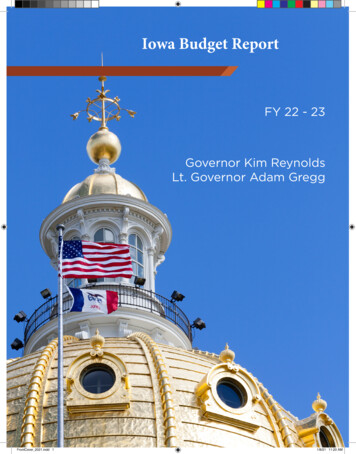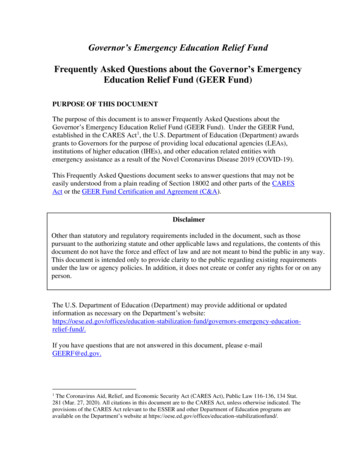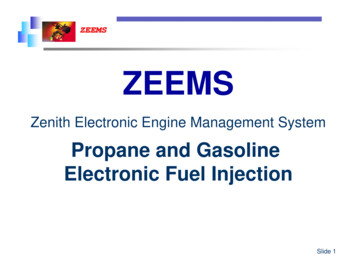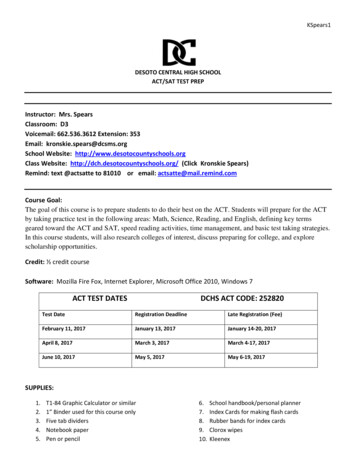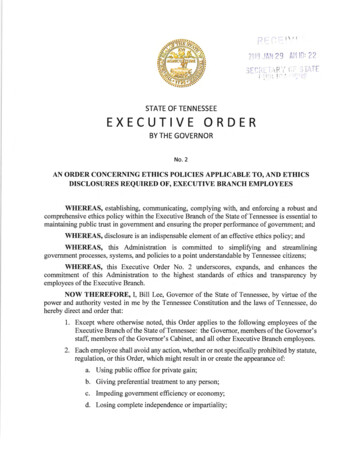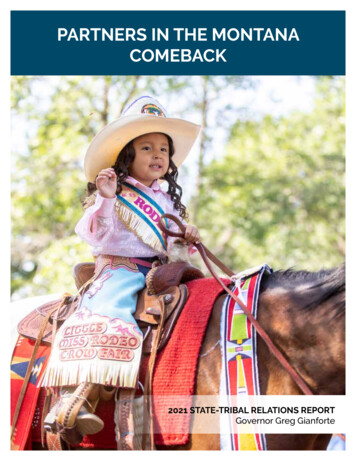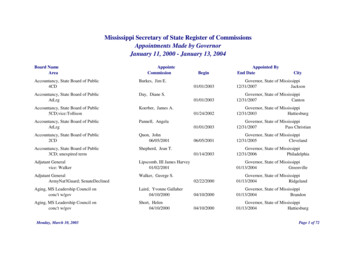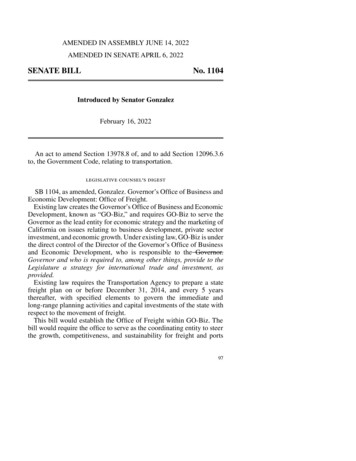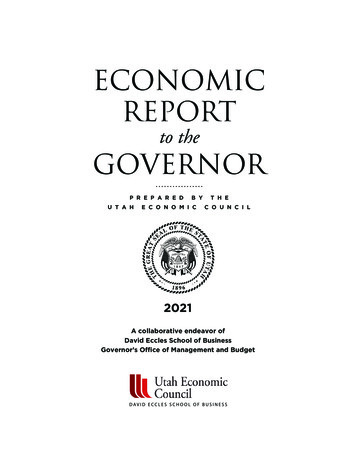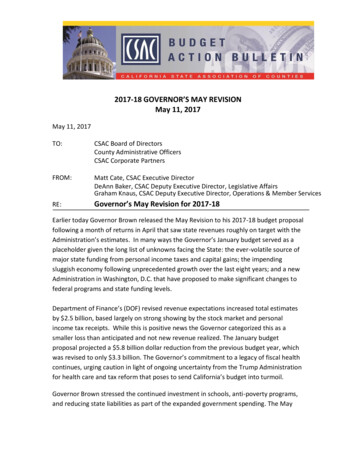
Transcription
2017-18 GOVERNOR’S MAY REVISIONMay 11, 2017May 11, 2017TO:CSAC Board of DirectorsCounty Administrative OfficersCSAC Corporate PartnersFROM:Matt Cate, CSAC Executive DirectorDeAnn Baker, CSAC Deputy Executive Director, Legislative AffairsGraham Knaus, CSAC Deputy Executive Director, Operations & Member ServicesRE:Governor’s May Revision for 2017-18Earlier today Governor Brown released the May Revision to his 2017-18 budget proposalfollowing a month of returns in April that saw state revenues roughly on target with theAdministration’s estimates. In many ways the Governor’s January budget served as aplaceholder given the long list of unknowns facing the State: the ever-volatile source ofmajor state funding from personal income taxes and capital gains; the impendingsluggish economy following unprecedented growth over the last eight years; and a newAdministration in Washington, D.C. that have proposed to make significant changes tofederal programs and state funding levels.Department of Finance’s (DOF) revised revenue expectations increased total estimatesby 2.5 billion, based largely on strong showing by the stock market and personalincome tax receipts. While this is positive news the Governor categorized this as asmaller loss than anticipated and not new revenue realized. The January budgetproposal projected a 5.8 billion dollar reduction from the previous budget year, whichwas revised to only 3.3 billion. The Governor’s commitment to a legacy of fiscal healthcontinues, urging caution in light of ongoing uncertainty from the Trump Administrationfor health care and tax reform that poses to send California’s budget into turmoil.Governor Brown stressed the continued investment in schools, anti-poverty programs,and reducing state liabilities as part of the expanded government spending. The May
Revision offers funding on previously approved programs, some of which werethreatened with cuts in the January budget, and debt payments: Partially mitigating impacts of the In-Home Supportive Services costs withappropriations to counties for the next four years (see below); School funding increase through the Local Control Formula by 1.4 billion; Restoring the 500 million child care to package from the 2016 that was “frozen” inthe January budget proposal; and Paying down 6 billion for unfunded pension liability to CalPERS, relying on theProposition 2 Rainy Day Account.This is in addition to the programs with on-going commitments approved in prior years: Repeal of Maximum Family Grant, which denied aid to children born to familieswhile their parents were receiving aid; Cost of living adjustments for the Supplemental Security Income/ StateSupplementary Payment (SSI/SSP); Continuation of the Earned Income Tax Credit for the poorest of California’s workingfamilies; Expansion of healthcare to undocumented children and Californians covered underthe Affordable Care Act; and Raising the state minimum wage, which will increase to 11 in 2018 and 15 forovertime hours.IHSS MOE Proposal ReleasedThe Governor’s May Revision is a notable improvement over the January budget thatcontained an approximate 623 million shift to counties beginning July 1, 2017, due tothe elimination of the five-year county maintenance of effort (MOE) for the In HomeSupportive Services (IHSS) program.Over the past several weeks, CSAC leadership, County Executive Officers, and CSAC staffhave been meeting with key members of the Governor’s administration, discussing waysto reduce the impact of the IHSS cost shift. As a result of these efforts, the May Revisionincludes 1.1 billion in state general fund contributions over the next four years tomitigate the 592.2 million cost shift to counties in year one and future years. The MayRevision also contains a commitment going forward to review the costs of the programwithin the structure of 1991 Realignment and the impact of the inflation factor.2
A detailed summary of the proposal is provided on page 17 of this Budget ActionBulletin.Please note, this edition of the Budget Action Bulletin reflects changes since theGovernor’s January Budget proposal. For more detail on any of these items, see theappropriate policy section below or contact CSAC legislative staff.3
SUMMARY CHARTS2017-18 May RevisionGeneral Fund Budget Summary( in millions)Prior Year BalanceRevenues and TransfersTotal Resources AvailableNon-Proposition 98 ExpendituresProposition 98 ExpendituresTotal ExpendituresFund BalanceReserve For Liquidation of EncumbrancesSpecial Fund for Economic UncertaintiesBudget Stabilization Account/Rainy Day Fund2016-17 4,515 118,540 123,055 71,729 50,603 122,332 723 980- 257 6,7132017-18 723 125,912 126,635 71,166 52,852 124,018 2,617 980 1,637 8,488General Fund Revenue Sources( in millions)Personal Income TaxSales and Use TaxCorporation TaxInsurance TaxAlcoholic Beverage Taxes and FeesCigarette TaxMotor Vehicle FeesOtherSubtotalTransfer to the Budget Stabilization /Rainy Day FundTotal42016-17 83,16124,49410,2102,4833757924727 121,5532017-18 88,96124,47010,8942,5383776524358 127,687 Change 5,800-24684552-140-369 6,134% 013-1,7751,238-41.1% 118,540 125,912 7,3726.2%
Long-Term Revenue Forecast – Three Largest Sources(General Fund Revenue - in billions)Personal Income TaxSales and Use TaxCorporation TaxTotalGrowth2015-16 78.7 24.9 10.52016-17 83.2 24.5 10.22017-18 89.0 24.5 10.92018-19 91.2 25.7 11.22019-20 93.8 26.6 11.82020-21 96.9 27.6 12.3 114.14.4% 117.93.3% 124.35.5% 128.13.1% 132.23.2% 136.83.5%Average YearlyGrowth4.2%2.1%3.2%3.7%General Fund Expenditures by Agency( in millions)Legislative, Judicial, ExecutiveBusiness, Consumer Services & HousingTransportationNatural ResourcesEnvironmental ProtectionHealth and Human ServicesCorrections and RehabilitationK-12 EducationHigher EducationLabor and Workforce DevelopmentGovernment OperationsGeneral Government:Non-Agency DepartmentsTax Relief/Local GovernmentStatewide ExpendituresTotal2016-17 2017-18 3,3333822412,8738533,66911,19453,57514,743127745 Change- 174-11216-151-5-1,0162502,762137-52-1,044% 9.1%-58.4%805459712 122,3326924351,924 124,018-113-241,212 1,686-14.0%-5.2%170.2%1.4%5
Administration of Justice2011 RealignmentThe Governor’s May Revision updates revenue assumptions for 2011 Realignmentprograms. While the 2016-17 statewide bases for the Community CorrectionsSubaccount (AB 109) remains 1.61 billion, the estimated growth funds that countieswill receive this fall have substantially decreased from the previous estimate of 59.1million to a revised estimate of 24.7 million, signifying a 55 percent drop. However, thismay change before finalization in the fall.Community Based Transitional Housing ProgramThe 2016 Budget Act included 25 million for a newly created program that encourageslocal governments to support transitional housing that provides treatment and reentryprogramming to individuals and offenders released from the criminal justice system.The May Revision broadens the purposes for which cities and counties may use theirprogram funds. The proposed statutory changes do the following: Allow cities and counties to provide a portion of their program funds to the facilityoperator, if the facility operator agrees to use those funds for facility operations andservices to residents. There is no limit on the amount the local jurisdiction mayprovide the facility operator. Allow cities and counties to use program funds for other purposes that theirgoverning boards determine are in furtherance of the program’s goals.Proposition 47 – Drug SentencingProposition 47 was approved by voters in November 2014, which requires misdemeanorrather than felony sentencing for certain property and drug crimes and permits inmatespreviously sentenced for these reclassified crimes to petition for resentencing.Proposition 47 requires state savings resulting from the proposition to be transferredinto the Safe Neighborhoods and Schools Fund. The May Revision projects savings of 45.6 million when comparing the population for 2016-17 with the 2013-14 population.This is an increase of 3.5 million over the estimated savings in 2015-16 and an increaseof 2.6 million over the Governor’s January budget proposal. Savings are currentlyestimated to increase to approximately 75 million by 2019-20.6
Proposition 57 – Sentencing Reform for Juveniles and AdultsProposition 57, passed by voters last November, reforms the juvenile and adult criminaljustice system in California by creating a parole consideration process for non-violentoffenders who have served the full term of their primary criminal offense in stateprison. The Governor’s January budget proposal estimated that Proposition 57 wouldresult in a net savings of 22.4 million in 2017-18, growing to a net savings ofapproximately 140 million in 2020-21. In the May Revision, the estimate for 2017-18savings increases to 38.8 million, growing to a net savings of 186 million in 2020-21.Post Release Community SupervisionThe May Revision increases the funding for Post Release Community Supervision (PRCS)to 15.4 million. This funding is for local probation departments to supervise theincrease in the average daily population of offenders on PRCS as a result of theimplementation of court ordered measures and Proposition 57.State HospitalsThe Department of State Hospitals continues to experience a significant increase in thenumber of Incompetent to Stand Trial (IST) referrals from local courts. While theAdministration has continued to add capacity for this population at the state and locallevel, the IST pending placement waitlist is at 550 individuals as of May 2017. The MayRevision includes 3.1 million from the General Fund to establish 24 additional jailbased competency treatment programs. The Administration continues to work withcounties and other partners to look for solutions including exploring opportunities forjoint-use facilities that would provide services to both State Hospital patients andappropriate jail populations.7
Agriculture, Environment and Natural ResourcesCONCLUDING THE EMERGENCY DROUGHT RESPONSEIn April, the Governor ended the statewide drought emergency. The recent droughtencompassed the driest four consecutive years in California history, and the recent2016-17 winter and spring have been extremely wet. Snowpack and reservoir levels arehigh, and some parts of the state have experienced record precipitation.The end of the drought is a positive step but long-term drought impacts remain.Additionally, the dramatic swing experienced over the last few years illustrates the needfor a flexible approach to address and adapt to variability associated with climatechange.The Governor’s January budget proposal included 178.7 million in emergency droughtfunding for a variety of program areas, including local assistance for small watersystems, tree mortality, enhanced fire protection, and funding to implement theGovernor’s Executive Order on water conservation. In the May Revision, the proposedfunding for drought response is reduced by 115 million for a total of 63 million. Thebulk of this funding is for Cal Fire for enhanced fire protection. Additional funding isincluded to close out various drought-related activities.Continuing Drought Response (All gWaterSupplies &WaterConservationDepartment of WaterResourcesWater BoardLocal Assistance forSmall CommunitiesWater RightsManagementDroughtManagement andResponseSave Our WaterCampaignEnhanced FireProtectionEmergencyResponse8Department of WaterResourcesDepartment of WaterResourcesDepartment ofForestry and FireProtectionJanuaryProposed(millions) 5MayRevise(millions) 5Increase(Decrease)(millions) 0 5.3 0.6( 4.7) 7 0( 7) 2 1 0 91 41.7( 49.3)
Office of EmergencyServicesProtectingFish andWildlifeTOTALDepartment of Fishand WildlifeCalifornia DisasterAssistance ActState OperationsCenterEmergency FishRescues andMonitoringDelta SmeltResiliency Strategy 52.7 8.5( 44.2) 4 0( 4) 8.2 2.6( 5.6) 3.5 3.5 0 178.7 62.9( 115)Tree MortalityThe drought and subsequent bark beetle infestation of our forests has resulted in anestimated 100 million dead and dying trees throughout the Sierra. As counties are wellaware, the Governor issued an Executive Order in October 2015 directing state and localentities as well as utilities to remove dead and dying trees that threaten criticalinfrastructure and pose a health and safety risk. The Governor’s Tree Mortality TaskForce has been working diligently to implement the Executive Order with many countiesactively participating.The May Revision includes reduced funding levels for the removal of dead or dying treescompared to the January budget proposal. A total of 8.5 million is included for Cal OESfor the California Disaster Assistance Act (CDAA), with 2 million for local agencies to aidin the removal of dead or dying trees. This is a reduction of 44.2 million from theGovernor’s January budget proposal, which included 52.7 million for CDAA.The funding proposal to assist with the effort and the increased fire risk posed by thestate of our forests was also reduced. The May Revision includes 38.7 million inGeneral Fund and 3 million in State Responsibility Area (SRA) funds for Cal Fire toincrease fire protection. This is 49.2 million lower than the 91 million included in theGovernor’s January budget proposal.However, the May Revision also includes ongoing resources for Cal Fire to respond toclimate adaptation changes. With several recent “hottest year” records, the fire seasonhas lengthened and the number of wildfires has increased dramatically. The May9
Revision includes 42 million in General Fund and 309,000 from various special fundsand reimbursements to expand the state’s firefighting capabilities and expand the fireseason. The funding will support 42 additional fire engines, capacity to staff engines andhelitack bases one month earlier in the spring, and extended peak staffing levels by twoweeks into the fall season. The goal is to reduce fire risk from climate change, drought,and tree mortality by completing more fuel reduction projects during the off-peakseason. The General Fund costs will be offset by lower expenditures in Cal Fire’sEmergency Fund.Making Water Conservation a Way of LifeDespite the Governor calling an end to the drought in April, the Administrationcontinues to focus on water conservation and their initiative to Make WaterConservation a Way of Life. Building off his 2016 Executive Order on water conservation,the May Revision includes additional funding to the State Water Resources ControlBoard to implement policy to: Require the State Water Resources Control Board, in consultation with theDepartment of Water Resources, to set long term urban water use efficiencystandards by May 20, 2021; Allow the State Water Board to set interim standards to ensure that progressbegins before the long-term standards are adopted in 2021; Include a robust public participation process to provide the State Water Boardand Department with critical input from local agencies, tribal governments,nongovernmental organizations, the business sector, academics, and others.In addition, the proposal would include agricultural water suppliers and require them to: Develop an annual water budget for the agricultural water service area; Identify agricultural water management objectives and implementation plans; Quantify measures to increase water use efficiency; Develop an adequate drought plan for periods of limited supply.ENHANCING DAM SAFETY AND FLOOD CONTROLIn response to the event at the Oroville Dam in February, the Governor is includingadditional funding in the May Revision for increased dam safety. Specifically, theAdministration is proposing legislation to require dams to have emergency action plans,updated every 10 years, and require dams to have updated inundation maps. In10
addition, the proposal would increase the Dam Safety Fund within the Department ofWater Resources to help improve action plans and conduct additional and moreextensive evaluations.The May Revision also include an increase of 387 million in Proposition 1 bond dollarsto accelerate and enhance flood protection in the Central Valley , the Sacramento- SanJoaquin Delta and other areas of the state facing significant flood risk.CANNABIS REGULATIONWith the passage of Proposition 64, the Adult Use of Marijuana Act (AUMA) and theMedical Cannabis and Regulatory Safety Act (MCRSA), California will be regulating andtaxing cannabis for medical and recreational purposes. The January budget proposalincluded 51.4 million for the regulation of cannabis in 2017-18 to fund state regulatoryactivities, processing of licenses, and enforcement. The May Revision builds off thiseffort and includes an additional 43.2 million for additional cannabis-related activities,for a total of 94.6 million in 2017-18. The Administration has also released updatedtrailer bill language on April 28 that seeks to consolidate and streamline the regulatoryframeworks under both AUMA and MCRSA, creating one single regulatory system. CSACis working with the Administration, Legislature and stakeholders to ensure that thestreamlined regulatory system respects all local control provisions included in AUMAand MCRSA. Proposition 64 requires the state to start issuing licenses for recreationalcannabis beginning January 1, 2018. Please see the proposed funding chart on thefollowing page.11
2017-18 Proposed Cannabis Resources(multiple Bureau of butors, testinglaboratoriesManufacturersDepartment of PublicHealthDepartment of Foodand AgricultureEnforcement Bureau of CannabisControlDepartment of PublicHealthDepartment of Foodand AgricultureDepartment of Fishand atoryServicesPermitting12State Water ResourcesControl BoardDepartment of Fishand WildlifeBureau of CannabisControlDepartment of PublicHealthDepartment of Foodand AgricultureState Water ResourcesControl BoardBureau of CannabisControlDepartment of PublicHealthDepartment of Fishand WildlifeState Water ResourcesJanuaryProposed(millions) 4.4MayIncreaseRevise (Decrease)(millions)(millions) 5.1 0.7 0 1.8 1.8Cultivation 1.6 3.9 2.3Inspection andInvestigationManufacturers 7.9 7.9 0 0 2.5 2.5 3 3.4 0.4 0 6.5 6.5 0 7.3 7.3Inspection andInvestigationLaw enforcementsupport for complianceinvestigationsInspection andInvestigationDevelop conditions forlicenses and permitsLicensing System 0 2.4 2.4 5.1 5.1 0Licensing System 1.4 2.3 0.9Track and Trace, andLicensing SystemCannabis Identificationand Prioritization SystemTesting Lab Contract 16.9 18.1 1.2 0 0.9 0.9 1.2 1.2 0Cannabis Testing( 0.4) 0.2 0.6 0 6.8 6.8 0 1.3 1.3Permitting for Lake andStreambed AlterationsWater Quality Rights
RestorationGrantsAdmin andOversightControl BoardDepartment of Fishand WildlifeBureau of CannabisControlDepartment of PublicHealthDepartment of Foodand AgricultureBoard of EqualizationState Water ResourcesControl BoardCannabis ControlAppeals PanelDepartment ofPesticide RegulationTOTALLocal Assistance 0 1.5 1.5Legal, Budgets,Accounting, HumanResourcesEducation, Training, andOutreachLegal, Budgets,Accounting, HumanResources, and OutreachExcise TaxImplementationFee Collections 4 4 0 0 3.5 3.5 0.9 0.9 0 5.4 5.4 0 0 0.3 0.3Appeals Panel Operations 0 1 1Training, Outreach,Education, and WorkerSafety 0 1.3 1.3 51.4 94.6 43.2Significant Adjustments: Department of Fish and Wildlife (DFW) – 17.2 million from multiple fund sourcesand 63 positions to support the development and implementation of the regulatoryprograms by the California Department of Food and Agriculture and the State WaterBoard. DFW will consult on fish and wildlife considerations related to thedevelopment of regulations and provide law enforcement to support regulatorycompliance efforts. Water Board – 9.8 million from multiple fund sources and 65 positions to develop astatewide water quality permit and expanded water rights registration process forcannabis cultivation. Department of Pesticide Regulation – 1.3 million from the Cannabis Control Fundto develop and update guidelines for pesticide use on cannabis, and prepare trainingprograms and outreach materials. Cannabis Control Appeals Panel – 1 million from the Cannabis Control Fund and 8positions to provide resources for the operations of the Appeals Panel.13
Bureau of Cannabis Control (formerly known as the Bureau of Marijuana Regulation)– 664,000 from the Cannabis Control Fund and 5 positions for environmentalreview as required by CEQA.Department of Public Health – 9.3 million from the Cannabis Control Fund toimplement cannabis manufacturer regulations, licensing, enforcement, training andinformation technology activities.Department of Food & Agriculture – 3.9 million from the Cannabis Control Fund andten positions for required environmental impact review activities.Government Finance and AdministrationThe May Revision leaves much unchanged from the Governor’s January budgetproposal. This includes the grant program for counties to partner with the US CensusBureau, the insufficient ERAF funding backfill, and funding to support the State-CountyAssessors’ Partnership Program provided in the Governor’s January budget proposal allremain unchanged in the revised budget proposal. Changes since the Governor’sJanuary budget are detailed below.EMPLOYEE RELATIONSIn-Home Supportive Services (IHSS) ProposalThe Administration and CSAC have been in close negotiations in the months followingDOF action that ended the Coordinated Care Initiative (CCI), which included the keyaspect of IHSS bargaining responsibilities being held by the state instead of counties.With the return of collective bargaining to all counties the May Revision proposalincludes the changes below. For a full summary of the IHSS proposal, please see theHealth and Human Services policy section of on page 17 of this document.1) Minimum Wage: The May Revision maintains the cost-sharing for minimum wageagreements above the state participation level of 12.10 per hour for wages andbenefits. Specifically, it maintains the 35 percent county/65 percent state share. It alsoproposes that the state participation cap should be 1.10 above the hourly minimumwage established by SB 3 (Chapter 4, Statutes of 2016), with adjustments for inflationonce the minimum wage reaches 15 per hour. The May Revision also provides that forcounties that are at or above the current state cap of 12.10, the state would maintainits 65 percent share up to a 10-percent increase over three years.14
2) Collective Bargaining: Effective July 1, the May Revise proposes that unionsrepresenting IHSS workers may appeal to the Public Employment Relations Board (PERB)if MOE bargaining is not concluded in within nine months. IHSS workers for both CCI andnon-CCI counties are already under the purview of PERB, which does not have anyadditional authority when making determinations impacting this group of representedemployees.Public Employment Relations Board (PERB) Funding AugmentationThe May Revision includes a General Fund expenditure of 750,000 for PERB to “addressthe Board’s budgetary pressures and provide the appropriate level of funding to supportexisting permanent positions.” Currently, PERB suffers a backlog of cases, preventingthe Board from providing timely decisions that currently take on average 190 days.While the appropriation is dedicated to support existing positions and not create newones, the augmentation is intended to increase PERB’s efficiency.GOVERNANCE AND FINANCEBoard of Equalization (BOE) Audit and Corrective ActionThe May Revision summarizes the Department of Finance (DOF) evaluation of the BOE’ssales and use tax reporting and the elected officers outreach activities. Their findingspointed to several troubling concerns related to operations and policies, or the lackthere of, that ran counter to state law and budgetary and legislative directives. It alsoshowed a failure by the BOE to demonstrate a corrective action plan to remedy a grossmisallocation of sales tax to counties, making it impossible for DOF to determine the sizeand scope of the error that could possibly range from 100 million to 300 million infavor of the state General Fund.Governor Brown issued a letter in response to the evaluation that included, amongother things, instructions for legislative leadership to convene and identify statutorychanges to provide corrective steps by June 2017. CSAC issued a letter shortly thereafterrequesting the opportunity to serve as a partner with the Administration and legislativeleadership given counties’ role in service delivery on behalf of the State.15
Also of note for the BOE, part of the IHSS proposal would include repayment forgivenessfor any amounts that counties may owe to the state through 2015-16 because of theBOE’s miscalculations of sales tax.STATE ECONOMIC FORECASTFor the near term, revenue forecasts for 2015-16 through 2017-18 have increased by 2.5 billion compared to the Governor’s January budget. This is attributed to strongstock market performance and higher personal income tax receipts despite lower-thanexpected sales tax receipts, which were revised down by 1.2 billion. Corporation taxrevenues showed a minor increase due to lower refunds and higher payments.The May Revision reports moderate growth is expected for four more years, whichwould add to one of the longest periods of growth since World War II. The long termforecast show an average yearly growth rate of 3.7%. Total general fund revenues areexpected to grow from 114.1 billion in 2015-16 to 136.8 billion in 2020-21.Risks to the state’s economic stability include stock market correction, geopolitical riskssuch as wars in the Middle East or conflicts in Asia or European Union, and the lingeringthreat of a recession. The risk of recession could be exacerbated by California’s housinggrowth that lags behind population growth and could potentially limit job markets aswell as consumer spending.Sales and Use Tax ProjectionsSales and use tax is one of the state’s “Big Three” revenues and is of particularimportance to counties as the primary source of funding for 1991 and 2011Realignment, Proposition 172 funds for public safety, transportation, and other localprograms. Counties receive almost half of sales and use tax revenues collected by thestate.As expected, the May Revision shows below average growth rates for sales and usetaxes. Revised projections estimate that sales and use taxes will generate approximately 24.5 billion in general fund revenues in both 2016-17 and 2017-18. This is slightly lowerthan the January budget proposal which estimated 25 billion in 2016-17 and 25.2billion in 2017-18.16
The May Revision cites weak business spending, lower housing permits, and inflation inhouse and medical costs as likely contributors to the lower sales tax revenues.Property Tax ProjectionsProperty taxes are primarily a source of local revenue, but high-level estimates areincluded in the state’s budget due to the complicated interactions with Proposition 98.The May Revision estimates that statewide property tax revenue will increase 4.9percent in 2016-17 and 5.4 percent in 2017-18. This is a minor change from theGovernor’s January budget proposal which projected 5.9 percent growth in 2016-17 and5.3 percent in 2017-18.Health and Human ServicesIN-HOME SUPPORTIVE SERVICES (IHSS) ProposalThe Governor’s May Revision is a notable improvement over the January 10 proposedbudget that contained an approximate 623 million shift to counties beginning July 1,2017, due to the elimination of the five-year county maintenance of effort (MOE) for theIn Home Supportive Services (IHSS) program. The May Revision now includes 1.1 billionin state general fund contributions over the next four years to mitigate the full revised 592.2 million IHSS cost shift to counties as well as an ongoing state general fundcontribution into future years.Counties will recall that the Governor’s January budget eliminated the county MOE andits attendant 3.5% annual inflator and reinstated the existing nonfederal IHSS costsharing ratio of 65 percent state and 35 percent county.The May Revision instead reinstitutes a county MOE structure with no inflator in 201718, rising to five percent in 2018-19, and seven percent in 2019-20 and beyond. Itincludes some protection for economic downturns by allowing the inflator to bereduced in half and as low as zero depending on sales tax performance starting in yearthree. The new MOE will have a new base, which will be developed with county input.17
This proposal would also redirect all Vehicle License Fee (VLF) growth revenues – notbase revenues – from the 1991 Realignment Health, Mental Health, and County MedicalServices Program (CMSP) subaccounts for three years. This VLF growth redirectionwould be halved in years four and five. The redirected CMSP revenues would beavailable to mitigate impacts to the 35 CMSP counties. The state would continue toredirect VLF growth from the Health Subaccount under AB 85 (Chapter 24, Statutes of2013) to continue to fund state CalWORKs costs.Overall, counties general funds are largely protected in years one and two by thesignificant state general fund contribution outlined in the May Revision and low annual,combined with existing 1991 Realignment growth revenues and other changes in howcounties are reimbursed for costs in the IHSS program. It represents only a smallincrease in costs beyond what was anticipated under the expired MOE.However, as structured in the May Revision, the seven percent inflator beginning in yearthree is problematic for counties and will
overtime hours. IHSS MOE Proposal Released The Governor's May Revision is a notable improvement over the January budget that contained an approximate 623 million shift to counties beginning July 1, 2017, due to the elimination of the five-year county maintenance of effort (MOE) for the In Home Supportive Services (IHSS) program.
